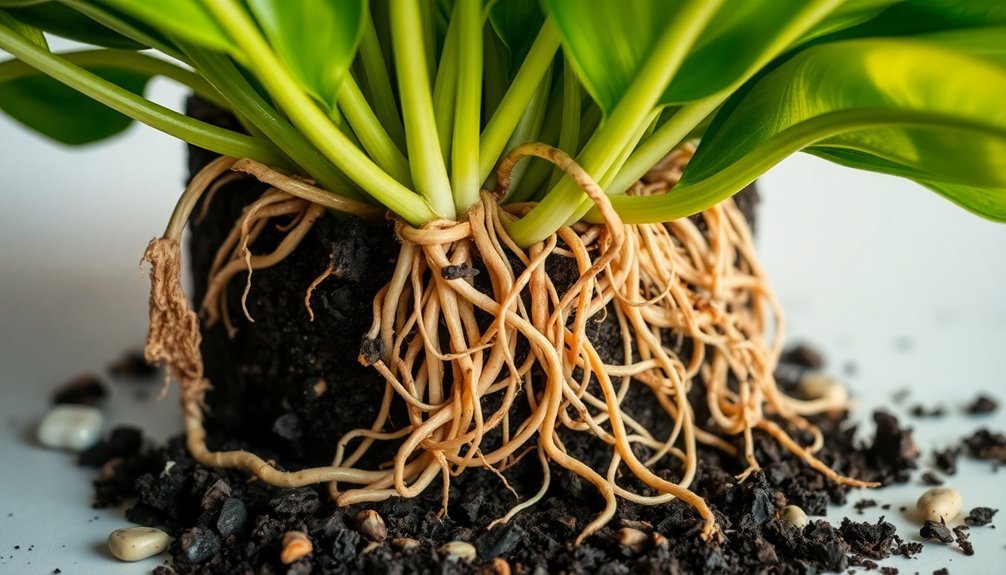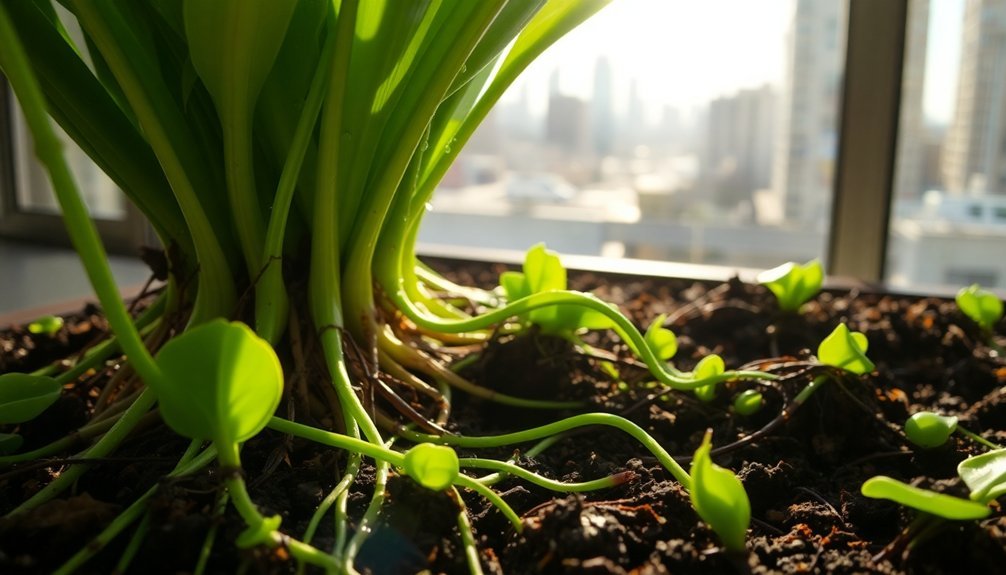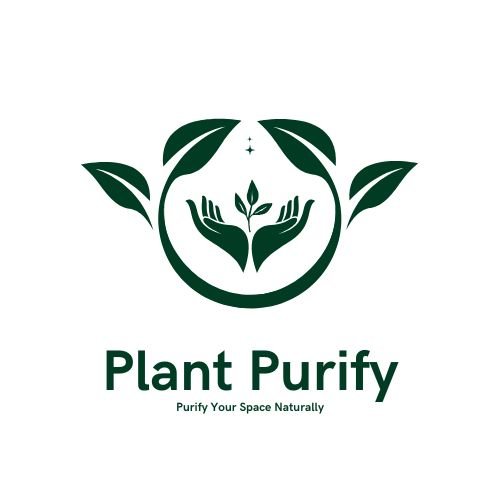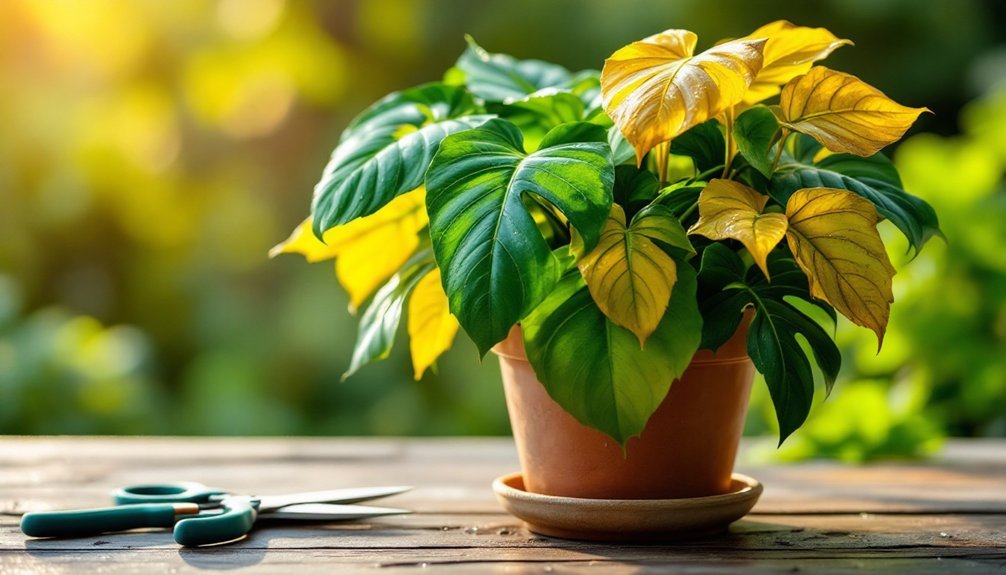Your air-purifying plants can develop root issues due to the delicate balance required between moisture and aeration. While these plants need adequate water to maintain their filtering abilities, over-watering creates oxygen-poor conditions that lead to root rot and fungal growth. You'll also find that poor soil choice and insufficient drainage compound these problems by restricting essential airflow to the roots. Understanding these core challenges will help you maintain healthier plants and maximize their air-cleaning power.
Common Root System Challenges in Air-Purifying Plants

While air-purifying plants can effectively clean indoor air, their root systems face several vital challenges that can compromise their performance. The most significant threat you'll encounter is root rot, often caused by over-watering and poor drainage in your pots.
When excess water can't escape, it creates an environment where harmful fungi thrive, damaging healthy roots.
Your soil choice plays an important role in preventing root issues. Compacted or dense soil restricts proper airflow and oxygen delivery to the roots, limiting their ability to absorb pollutants.
Additionally, you'll need to maintain balanced humidity and adequate air circulation around your plants to prevent stagnant conditions.
Watch out for fungus gnats, as these pests can introduce pathogens that further harm your air-purifying plants' root systems.
Understanding Soil Requirements for Optimal Root Health
Since healthy root systems depend on proper soil composition, choosing the right potting mix is essential for your air-purifying plants.
Poor drainage and over-watering can quickly lead to root rot, compromising your plants' ability to thrive. You'll want to avoid using outdoor soil, which can harbor harmful pathogens that damage root health.
- Select a chunky, well-draining potting mix that promotes proper aeration
- Always use containers with drainage holes to prevent water stagnation
- Monitor soil moisture levels regularly to maintain ideal root conditions
- Verify your potting mix allows excess water to drain freely
Environmental Factors Affecting Root Development

Four critical environmental factors can make or break your air-purifying plants' root development: water levels, light exposure, humidity, and air circulation.
Over-watering is often the main culprit behind root rot, creating oxygen-poor conditions that suffocate roots. When you combine this with poor soil choice, particularly dense or compact substrates, you're limiting essential airflow to the roots.
Your indoor plants also need adequate light exposure for healthy root development, as insufficient light reduces photosynthesis and weakens the entire plant system.
High humidity levels can encourage fungal growth, while poor airflow creates stagnant conditions that increase moisture retention in the soil.
To protect your plants' roots from these environmental factors, guarantee proper drainage, maintain appropriate watering schedules, and create sufficient air circulation around your potted plants.
Root Disease Prevention and Management Strategies
Understanding these environmental challenges leads us to effective root disease prevention strategies.
To protect your air-purifying plants from root diseases while they filter airborne pollutants, you'll need to focus on proper plant care fundamentals.
- Always check soil moisture levels before watering and guarantee your pots have adequate drainage to prevent root rot.
- Use only sterilized tools when handling your plants to avoid spreading pathogens between specimens.
- Choose a well-aerated potting mix that provides ideal drainage and airflow to meet your plant's needs.
- Maintain a consistent watering schedule, but never share water between plants, as this can spread disease.
Maximizing Air Filtration Through Healthy Root Systems

While many focus solely on leaf surface area for air purification, a plant's root system plays an essential role in filtering indoor pollutants.
You'll maximize air filtration by maintaining healthy root systems through proper care and attention to the root-soil zone.
To enhance your plant's ability to detoxify harmful substances, guarantee adequate airflow and humidity around the roots. You can improve root zone aeration by choosing well-draining pots and trimming lower leaves regularly to increase air exposure.
Don't forget to remove soil debris that might block air circulation.
Remember that roots work with microorganisms to break down airborne pollutants effectively.
Frequently Asked Questions
Why Do Air Plants Not Have Roots?
You'll find that air plants don't need traditional roots because they've evolved to use trichomes, tiny hair-like structures, to absorb water and nutrients directly from the air while using small anchoring structures for attachment.
What Causes Poor Root Growth in Plants?
Your plants' poor root growth can stem from over-watering, under-watering, compacted soil, poor drainage, soil pathogens, and environmental stress. These factors can suffocate, damage, or inhibit healthy root development.
What Plant Is NASA Recommend for Air Purifiers?
You'll find NASA recommends spider plants, peace lilies, Areca palms, and rubber plants for air purification. These powerhouse plants can effectively remove toxins like formaldehyde, benzene, and ammonia from your indoor air.
What Happens if Plant Roots Are Exposed to Air?
When your plant's roots are exposed to air, they'll quickly dry out, causing dehydration and stress. You'll notice reduced nutrient absorption, compromised growth, and potential root damage if you don't cover them with soil promptly.
In Summary
You'll find that maintaining healthy roots in air-purifying plants requires consistent attention to soil conditions, watering practices, and environmental factors. When you provide proper drainage, appropriate humidity, and balanced nutrients, you're setting your plants up for success. Remember, a robust root system directly impacts your plant's air-filtering capabilities, so don't neglect these underground heroes. Keep monitoring root health to maximize your indoor air quality benefits.





Leave a Reply